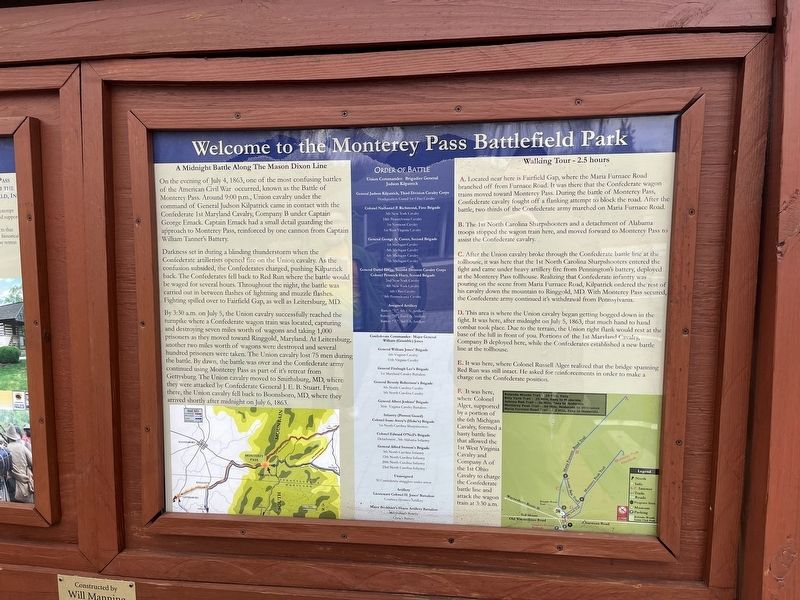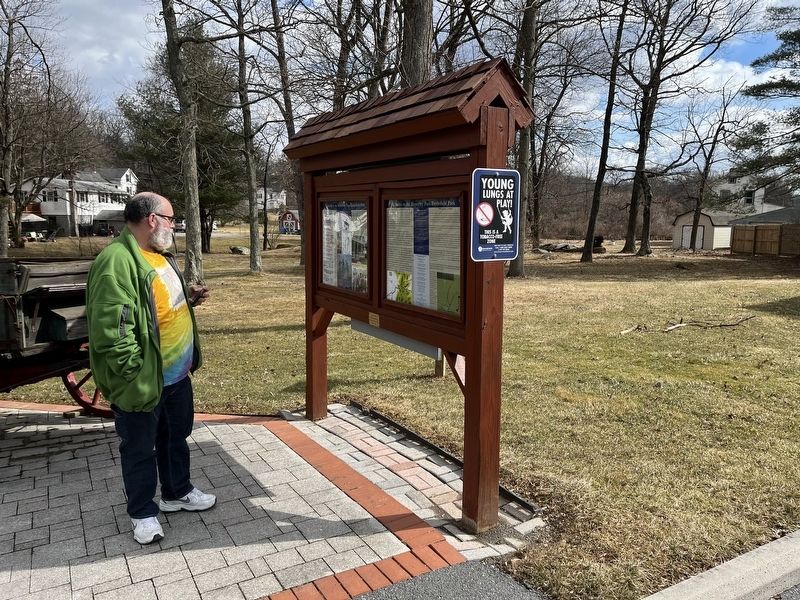Washington Township near Waynesboro in Franklin County, Pennsylvania — The American Northeast (Mid-Atlantic)
Welcome to the Monterey Pass Battlefield Park

Photographed By Devry Becker Jones (CC0), February 19, 2022
1. Welcome to the Monterey Pass Battlefield Park Marker
A Midnight Battle Along The Mason Dixon Line
On the evening of July 4, 1863, one of the most confusing battles of the American Civil War occurred, known as the Battle of Monterey Pass. Around 9:00 p.m., Union cavalry under the command of General Judson Kilpatrick came in contact with the Confederate 1st Maryland Cavalry, Company B under Captain George Emack. Captain Emack had a small detail guarding the approach to Monterey Pass, reinforced by one cannon from Captain William Tanner's Battery.
Darkness set in during a blinding thunderstorm when the Confederate artillerists opened fire on the Union cavalry. As the confusion subsided, the Confederates charged, pushing Kilpatrick back. The Confederates fell back to Red Run where the battle would be waged for several hours. Throughout the night, the battle was carried out in between flashes of lighting and muzzle flashes. Fighting spilled over the Fairfield Gap, as well as Leitersburg, MD.
By 3:30 a.m. on July 5, the Union cavalry reached the turnpike where a Confederate wagon train was located, capturing and destroying seven miles worth of wagons and taking 1,000 prisoners as they moved toward Ringgold, Maryland. At Leitersburg, another two miles worth of wagons were destroyed and several hundred prisoners were taken. The Union cavalry lost 75 men during the battle. By dawn, the battle was over and the Confederate army continued using Monterey Pass as part of it's retreat from Gettysburg. The Union cavalry moved to Smithsburg, MD, where they were attacked by Confederate General J.E.B. Stuart. From there, the Union cavalry fell back to Boonsboro, MD, where they arrived shortly after midnight on July 6, 1863.
Walking Tour - 2.5 hours
A. Located near here is Fairfield Gap, where the Maria Furnace Road branched off from Furnace Road. It was there that the Confederate wagon trains moved toward Monterey Pass. During the battle of Monterey Pass, Confederate cavalry fought off a flanking attempt to block the road. After the battle, two-thirds of the Confederate army marched on Maria Furnace Road.
B. The 1st North Carolina Sharpshooters and a detachment of Alabama troops stopped the wagon train here, and moved forward to Monterey Pass to assist the Confederate cavalry.
C. After the Union cavalry broke through the Confederate battle line at the tollhouse, it was here that the 1st North Carolina Sharpshooters entered the fight and came under heavy artillery fire from Pennington's battery, deployed at the Monterey Pass tollhouse. Realizing that Confederate infantry was pouring on the scene from Maria Furnace Road, Kilpatrick ordered the rest of his cavalry down the mountain

Photographed By Devry Becker Jones (CC0), February 19, 2022
2. Welcome to the Monterey Pass Battlefield Park Marker
D. This area is where the Union cavalry began getting bogged down in the fight. It was here, after midnight on July 5, 1863, that much hand to hand combat took place. Due to the terrain, the Union right flank would rest at the base of the hill in front of you. Portions of the 1st Maryland Cavalry, Company B deployed here, while the Confederates established a new battle line at the tollhouse.
E. It was here, where Colonel Russell Alger realized that the bridge spanning Red Run was still intact. He asked for reinforcements in order to make a charge on the Confederate position.
F. It was here, where Colonel Alger, supported by a portion of the 6th Michigan Cavalry, formed a hasty battle line that allowed the 1st West Virginia Cavalry and Company A of the 1st Ohio Cavalry to charge the Confederate battle line and attack the wagon train at 3:30 a.m.
General Judson Kilpatrick, Third Division Cavalry Corps
Headquarters Guard 1st Ohio Cavalry
Colonel Nathaniel P. Richmond, First Brigade
5th New York Cavalry 18th Pennsylvania Cavalry 1st Vermont Cavalry 1st West Virginia Cavalry
General George A. Custer, Second Brigade
1st Michigan Cavalry 5th Michigan Cavalry 6th Michigan Cavalry 7th Michigan Cavalry
General David Gregg, Second Division Cavalry Corps Colonel Pennock Huey, Second Brigade
2nd New York Cavalry 4th New York Cavalry 6th Ohio Cavalry 8th Pennsylvania Cavalry
Assigned Artillery
Battery "E", 4th U.S. Artillery Battery "M", 2nd U.S. Artillery Battery "C", 3rd U.S. Artillery
Confederate Commander: Major General William (Grumble) Jones
General William Jones' Brigade
6th Virginia Cavalry 11th Virginia Cavalry
General Fitzhugh Lee's Brigade
1st Maryland Cavalry Battalion
General Beverly Robertson's Brigade
4th North Carolina Cavalry 5th North Carolina Cavalry
General Albert Jenkins' Brigade
36th Virginia Cavalry Battalion
Infantry (Provost Guard) Colonel Isaac Avery's (Hoke's) Brigade
1st North Carolina Sharpshooters
Colonel Edward O'Neil's Brigade
Detachment, 5th Alabama Infantry
General Alfred Iverson's Brigade
5th North Carolina Infantry 12th North Carolina Infantry 20th North Carolina Infantry 23rd North Carolina Infantry
Unassigned
50 Confederate stragglers under arrest
Artillery Lieutenant Colonel H. Jones' Battalion
Courtney Henrico Artillery
Major Beckham's Horse Artillery Battalion
Mooreman's Battery Chew's Battery
Topics. This historical marker is listed in this topic list: War, US Civil. A significant historical date for this entry is July 4, 1863.
Location. 39° 44.262′ N, 77° 28.761′ W. Marker is near Waynesboro, Pennsylvania, in Franklin County. It is in Washington Township. Marker is on Buchanan Trail East (Pennsylvania Route 16) east of Charmian Road, on the left when traveling west. Touch for map. Marker is at or near this postal address: 14325 Buchanan Trail E, Waynesboro PA 17268, United States of America. Touch for directions.
Other nearby markers. At least 8 other markers are within walking distance of this marker. 12-Pounder Napoleon (a few steps from this marker); 3-Inch Ordnance Rifle (a few steps from this marker); Battle of Monterey Pass / Michigan Cavalry Brigade (within shouting distance of this marker); Corporal Joseph Brubaker, Jr. (within shouting distance of this marker); South Mountain (within shouting distance of this marker); The Battle of Monterey Pass (within shouting distance of this marker); a different marker also named The Battle of Monterey Pass (within shouting distance of this marker); Brown's Spring (about 300 feet away, measured in a direct line). Touch for a list and map of all markers in Waynesboro.
Credits. This page was last revised on February 7, 2023. It was originally submitted on February 21, 2022, by Devry Becker Jones of Washington, District of Columbia. This page has been viewed 210 times since then and 37 times this year. Photos: 1, 2. submitted on February 21, 2022, by Devry Becker Jones of Washington, District of Columbia.